 Museum
Museum  |
Bomber Command
|
Aircrew Chronicles
|
Aircrew Losses
|
Nose Art
|
BCATP
|
Lancaster
|
Media
|
Bomber Command
|
Aircrew Chronicles
|
Aircrew Losses
|
Nose Art
|
BCATP
|
Lancaster
|
Media
 Museum
Museum  |
Bomber Command
|
Aircrew Chronicles
|
Aircrew Losses
|
Nose Art
|
BCATP
|
Lancaster
|
Media
|
Bomber Command
|
Aircrew Chronicles
|
Aircrew Losses
|
Nose Art
|
BCATP
|
Lancaster
|
Media
Bomber Command Museum Chronicles
Downham Market is a small market town adjacent to "The Fens" in Norfolk, England. The Great Ouse river, together with a large "relief channel" that parallels it, pass just to the west of the town near the railway station, taking water removed from this reclaimed area to the sea at "The Wash." Much of Downham Market is little changed since World War II when the airmen based at the RAF station two kilometers east of the town-centre would have arrived by rail. Ian Bazalgette VC was one of these airmen, being posted to No. 635 Squadron at RAF Downham Market on 5 May, 1944.
As we passed through the station in May 2008, we noted that the old, at least by Canadian standards, station is well maintained and features the unique rockwork characteristic of Norfolk buildings.
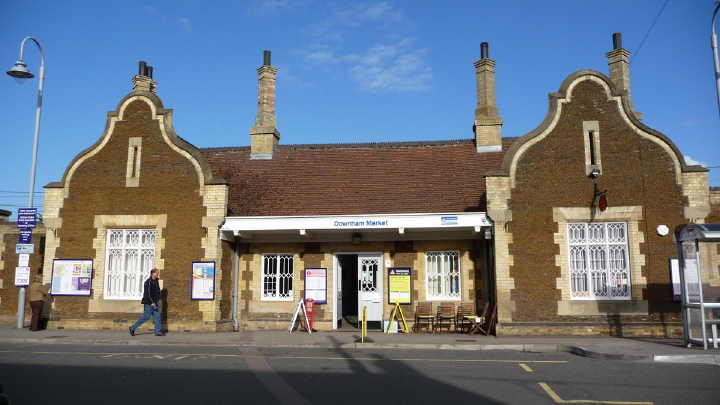
A winding road leads up the gentle hill to the town centre, a fresh coat of asphalt being one of the few changes from the days when Baz and his crew would have used it to reach the airfield. Mrs. Plumb operates the B&B at which we were staying at the bottom of the hill and she recommended "The Crown" for supper. We climbed the hill, reaching the pub at the town centre and located the un-marked entrance to the pub a short distance along a "carriageway" that left the main road through a stone gate.
Upon entering the pub we immediately noticed two large photos of No. 635 Squadron personnel lined up in front of a Lancaster. As well, there were a couple of smaller photos of RAF personnel and two squadron crests. The squadron photos were taken during May 1945 and, we presume, were left by the departing aircrew at the end of the war. At the opposite end of the pub was a large fireplace and it was easy to envision Baz, his crew, and other airmen standing around it and singing the classic air force songs, beers in hand. Later, our friend Don Currie who had also served with the squadron at Downham Market, assured us that indeed, this was one of the squadron's favourite pubs.
|
 No. 635 Squadron photos hanging in "The Crown" pub. |
The following morning we were met by Elizabeth Howard, a local resident with a particular interest in the history of RAF Downham Market and the small church that adjoins the former station. Elizabeth drove us through the town and into the farmland to the east. As the road crossed the A-10 highway and became the B-1122, Elizabeth pointed out that the section of the A-10 to the north was built on one of the station's runways. After driving another kilometre to the east, we arrived at a Memorial near the entrance to Bexwell Church. The Memorial contains three brass plaques, one referring to the station itself.
No. 218 Squadron RAF arrived here in August 1942, flying the Stirling against the Nazis. Later, No. 623 Squadron and No. 214 operated these massive aircraft from the base. The Stirlings left Downham at the end of 1943 and in March 1944, Lancasters of the newly formed No. 635 Squadron arrived. Later they would be joined on the station by No. 608 Squadron's Mosquitoes. The second plaque honours F/Sgt. Arthur Louis Aaron, a pilot with No. 218 Squadron. F/Sgt Aaron took off from Downham Market on 12 August, 1943 on a raid to Turin, Italy. He was posthumously awarded the Victoria Cross for his actions on that night that undoubtedly saved the lives of his crewmen. The third plaque is to the memory of S/L Ian Bazalgette who departed Downham Market on 4 August, 1944. He was killed when his Lancaster exploded after he landed with two badly injured crewmembers on board near the village of Senantes, France. Bexwell Church is a "round-towered" type of Saxon origin and was built prior to 1087. It is surrounded by large trees and a stone wall. Elizabeth is one of a small group that maintains the building and churchyard and documents the church's historical significance. As we entered the church, just inside the ancient door was a table with photos of some of RAF Downham Market's WW II aircrew. |
 Memorial at Bexwell Church. |
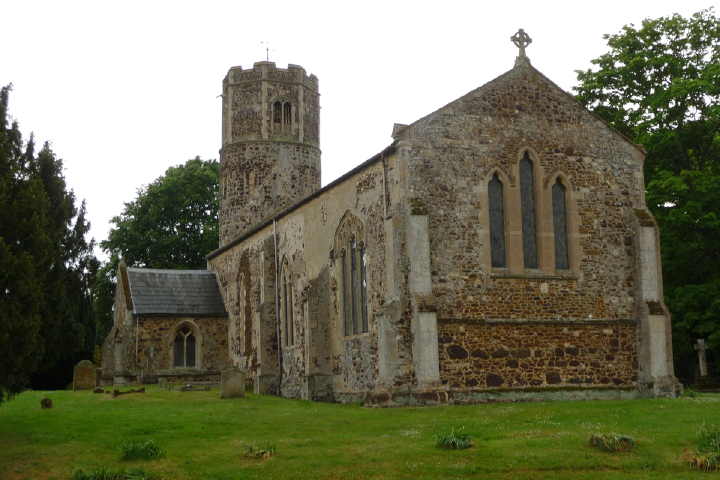
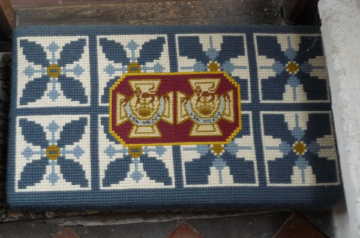 Kneeling cushion at Bexwell Church. |
To the left of the altar is the wooded cross that was placed over the original grave of 2nd Lt. C.D. Prangley, the rector's son who was killed in 1916 at the Battle of the Somme. The cross was removed when 2nd Lt. Prangley was re-interred in a military cemetery. To the right of the altar is a Memorial to the World War II airmen who visited the church. Many of the kneeling cushions in the church featured RAF crests and aircraft. We know that Ian Bazalgette kept a bible next to his bed while stationed at Downham Market and undoubtedly he, and numerous other airmen, would have attended services in Bexwell Church. |
To the north of the church, across the A1122, were the remains of the station -abandoned since 1946. As mentioned, one of the runways formed the basis of the A-10 highway but only traces of others may be seen today on Google Earth (52° 36' 33.11" N; 0° 24' 31.17" E -note the former base buildings immediately south of this point, Bexwell Church farther south across the A-1122, and the town of Downham Market to the west). However portions of the tarmac remain, as well as sidewalks and the minor roads that connected the various buildings on the station. It was raining lightly as we walked amongst the remaining buildings, surrounded by bushes and overgrown with vines. We entered one or two, including one with a large fireplace. Was this the Officers' Mess, another spot where Baz, his crew, and other airmen sang the classic air force songs, beer in hand? Elizabeth told us that she expected the property to be sold soon, the buildings to be torn down and replaced by a housing development.
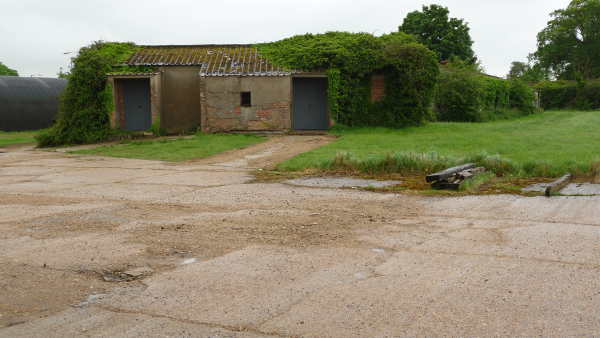
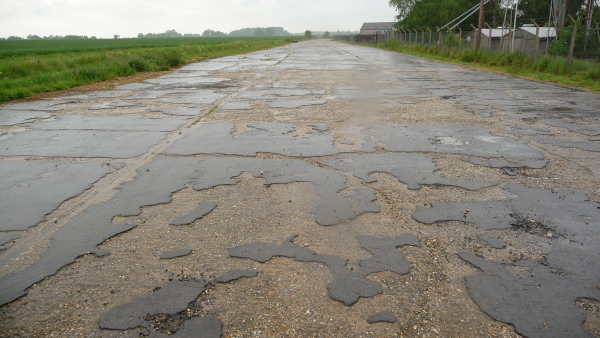
As we walked along the tarmac, we visualized Baz and crew, parachutes in hand, climbing into the truck during the morning of 4 August, 1944 to be taken to the dispersal where Lancaster F2-T awaited. Three and a half hours later F2-T would be in flames with only the port-outer engine operating. Four of Baz's crewmembers abandoned the aircraft as it approached the French village of Senantes.
Philippe Uziel, a member of the Bomber Command Museum, lives in central Paris. A few months earlier, together with his wife Françoise and son Guillaume, Philippe had visited Senantes and met Siméon Desloges who, as a nine year old boy, had watched Lancaster F2-T fly over his father's farm, just north of Senantes. Siméon is also a member of the local veterans association. Arrangements had been made for us to meet with Siméon and ask him what he could recall seeing during the final minutes of the Victoria Cross flight.
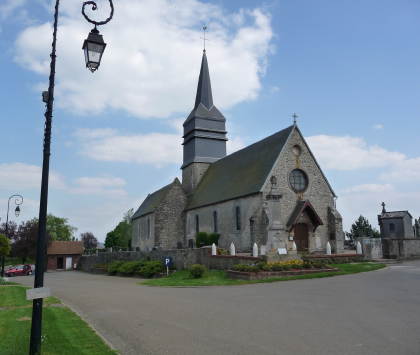 The Church at Senantes. |
Philippe picked us up at our hotel, skillfully navigated the streets of downtown Paris, and drove through the Parisian suburbs and into the countryside north of Paris. We passed through Beauvais, enjoying a glimpse of its historic cathedral prior to heading west and then north along narrow, winding roads. Soon the spire of a church appeared and shortly after, we entered Senantes (49° 29' 10.16"; 1° 50' 08.04" E). The small village appears to have changed little since 1944 -the church remaining the centre-piece, surrounded by several dozen stone houses. We saw no sign of any commercial activity. There was a man mowing the boulevards of the square in front of the church and a young couple fishing in a nearly pond. |
We drove about 3/4 of a kilometre north of Senantes, stopping at a roadside Memorial next to the field where Baz landed F2-T. Philippe then drove another 3/4 kilometres and entered the yard of the farm where Siméon Desloges has lived all his life. Siméon and his wife welcomed us and, after exchanging pleasantries, I asked him what he saw on 4 August, 1944.
Siméon told us how he had seen the Lancaster flying west over Senantes and parachutes being deployed. He then drew a line on our map, indicating how the aircraft had made a 180 degree turn, flew to the east and then to the north before turning west again, flying very low and directly over Siméon's farm yard. It then turned south and landed in a field only 750 metres to the south. He recalled that his brother had thought it was the end of the world as the blazing aircraft flew over. Then he heard the huge explosion when the Lancaster blew up and subsequent explosions as oxygen bottles and ammunition detonated.
We know that Baz's starboard wing had been on fire for about fifteen minutes and that the port-outer engine was the only one still running when they reached the Senantes area. I asked Siméon if he remembered the amount of fire and smoke that was trailing the aircraft. He answered by saying that there was very little smoke but lots of fire trailing from the starboard wing.
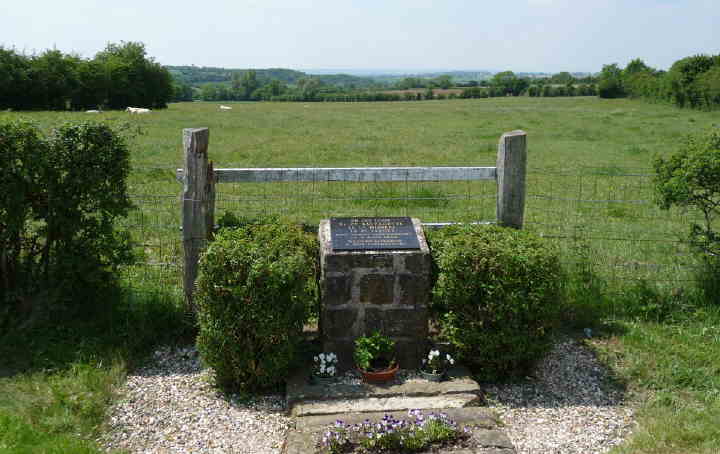
After enjoying coffee and a drink from Siméon's very special bottle of "vintage apple liqueur," we walked out into the yard to leave. Siméon went to his barn and from a stack of various pieces of wood and metal, pulled out a two metre long piece of aluminum. He said that it was the only remaining piece of F2-T in existence. He had brought it home from the crash site because of the bolts it had contained -bolts and other hardware being unavailable to the occupied French farmers during the war. Clearly, it was now an important keepsake. Photos were taken of Siméon and this historic piece of F2-T, and then we returned to Senantes for a closer look at the church. A unique design, it appears to be very old but is well maintained. As we had noticed earlier in the day, its spire dominates the village. Baz undoubtedly would have been aware of the village and the church. He must have flown directly over it as his wireless operator and navigator landed within a few hundred metres of church after abandoning the aircraft at a very low altitude. |
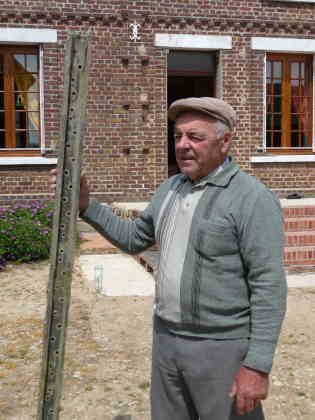 Siméon holding a piece of F2-T. |
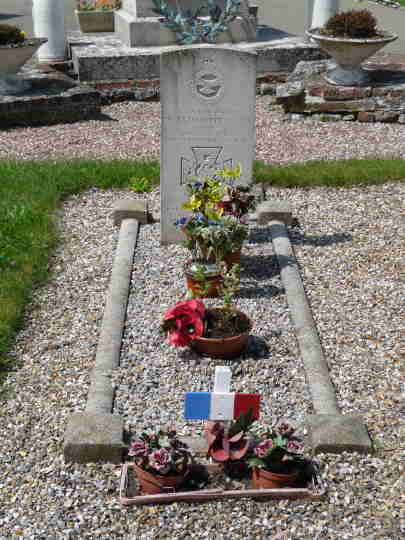 Baz's grave. |
Baz's grave is just inside the churchyard, to the left of the short path that leads to the main door of the church. Obviously located in a place of honour, there were some artificial flowers on it as well as a container with living plants. The churchyard is practically covered with large monuments and blocks of polished stone covering many of the graves. Baz's RAF headstone is very modest in comparison. It features the outline of the Victoria Cross and the quotation, "Greater Love hath no man than this, that a man lay down his life for his friends." As Philippe drove us along the winding roads of the French countryside leading back towards Paris, we left Senantes pleased with the knowledge that our museum in Nanton, just 85 kilometres south of Baz's birthplace, is taking the leading role in telling his story. With the help of his family, crewmembers, and others, our museum has and is continuing to research and document his personality, career, and the circumstances that led to S/L Bazalgette being awarded a Victoria Cross -the only one received by an Albertan during World War II. |